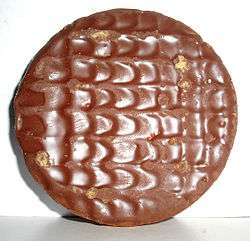Chocolate biscuit
A chocolate biscuit is a biscuit which is covered in chocolate, or which has been made by replacing some of the flour with cocoa powder.
 A chocolate-covered digestive biscuit | |
| Type | Biscuit |
|---|---|
| Main ingredients | Flour, cocoa powder or chocolate |
Chocolate biscuits are quite popular in places all over the world.[1] The composition and recipe may vary considerably and there is often legislation to specify how the biscuit may be described. In the UK, a biscuit made without an external coating may only be described as "chocolate" if it contains at least 3% of dry cocoa solids.[2] If there is a coating, this must contain cocoa butter as the fat to be described as chocolate, rather than just "chocolate-flavoured".[1]
Tax
The exact structure and composition is significant in determining the taxation applicable in the UK as valued-added tax (VAT). The general principle is that luxury foods such as confectionery are taxable, while basic foodstuffs are not. Case law and rulings have determined that a chocolate-covered biscuit such as a chocolate digestive or Kit Kat is taxable while a chocolate-chip cookie or Jaffa cake is not.[3][4]
References
- Duncan Manley (1998), Biscuit, Cookie and Cracker Manufacturing Manuals, 5. Secondary Processing in Biscuit Manufacturing, Elsevier, p. 22, ISBN 9781855736245
- P. R. Whitely (2012), Biscuit Manufacture: fundamentals of in-line production, Springer Science & Business, p. 79, ISBN 9781461520375
- "The bounds of confectionery, sweets, chocolates, chocolate biscuits, cakes and biscuits: Chocolate biscuits", VFOOD6240 - Food: Excepted items: Confectionery, Her Majesty's Revenue & Customs
- John Connell (9 August 2012), "Bitter-sweet rules on chocolate very taxing for Cumbrian shoppers", News & Star
